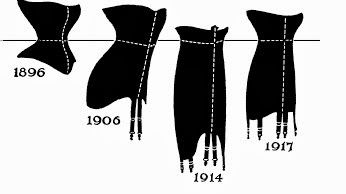Here is the measuring guide for this book, which I've made into a page where I can record measurements, and then follow the book's directions for making up a basic pattern or sloper.
Notice the droop of the bustline and the corresponding narrowness at the back. A lot of this is created by the underwear, which is so important to wear when measuring and fitting. Women wore a camisole or camisette (one-piece camisole and drawers) with a corset on top which reached from the thigh to just under the bust. Essentially, the bust was not supported or pulled up as much as we are used to today. If you are really gung-ho about this, there is an excellent free pattern and tutorial from Festive Attyre for a c. 1916 corset. Jen's pattern and directions are clear and as easy as you'll get when making up such a complicated garment.
I'm an older (choke, clear throat) woman, and a good corset would be necessary for me to get this shape. I'm going to work on that for the Historical Sew Fortnightly Challenge on Shape and Support, although I need it now! When I was a child in the 60s, I spent a couple of weeks every summer, staying with my grandmother. A few times, I caught a glimpse of her strapping on her girdle, as she called it. I have researched shapes of corsets, and I swear, that woman still wore the late teens model. She wasn't a heavy person, but I suppose once you are used to wearing a thing like that, you feel all out there without it. There's Grandma - 1917. She'd have been 24 years old when she bought that corset. And it must have cost a pretty penny.












